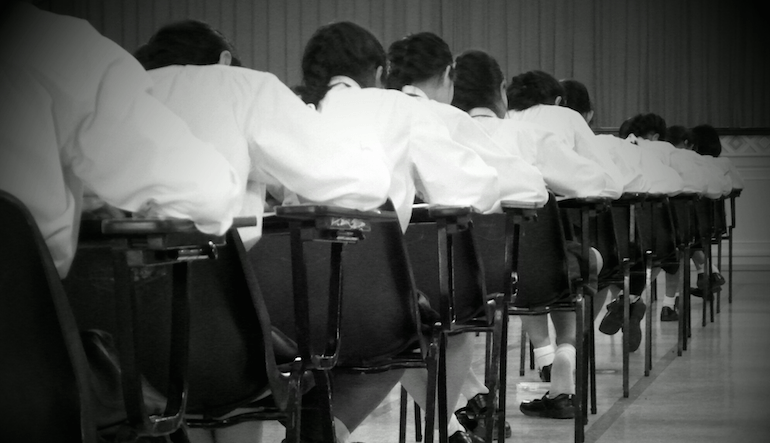Constructing Selves: Character in Sarah Shun-Lien Bynum’s “Accomplice”

I’ve written before about the magic I find, as a writer and reader, in the world of the school as a setting for fiction. Like most of my predilections when it comes to literature, gravitating toward this world isn’t really a conscious choice. But I think it has to do with the change that’s part of a classroom setting—that’s in fact part of that setting’s very definition. There’s a shaping of selves, intentional and otherwise, inherent in a school that creates a whole host of dramatic possibilities.
Sarah Shun-Lien Bynum’s short story “Accomplice,” which is set in a school, is one of my favorite short stories to teach in fiction workshops. As a teacher and writer, I find it so instructive in the way it builds its characters, and in the beautiful use it makes, to this end, of the richness of the classroom; as a reader, I just find that Bynum has filled her classroom-world with people I feel like I know, and would gladly follow wherever they take me. From Bynum’s Ms. Hempel Chronicles (which is sometimes billed as a novel, but is really a linked story collection, and a great one), “Accomplice” traces a young seventh-grade teacher’s questionable pedagogical choices. It begins by foregrounding the difficulty of capturing people on the page. Ms. Hempel is, at the start of the story, dreading the writing of her “anecdotals”–narratives about her students:
On average she would spend an hour writing about each child, and then waste up to another hour rereading what she had just written, in the hopes that her words might suddenly reveal themselves as judicious. But too often Ms. Hempel’s anecdotals reminded her of those blurry portraits from photography’s early days: Is that a hand I see? A bird? The sitter has squirmed, readjusted her skirts, swatted at a fly: she is no longer a child, but a smudge of light. This is how Ms. Hempel’s students appeared, captured in her anecdotals: bright and beautiful and indistinct.
I think there’s something wonderful about this open acknowledgment of how hard it is to render a person distinctly in words in a story that manages to capture its characters with warmth and particularity. The students here are perfect in their seventh-grade-ness: David D’Souza, “a little chubby and overcurious about sex . . . a very popular boy in the seventh grade”; Emily Borowitz, a “capricious child, aspiring trapeze artist, lover of Marc Chagall”; Henry Woo, a “sad sack, hanger-on, misplacer of entire backpacks”; Will Bean, a “friendly, benign irritant, someone who pops up from behind desks and briskly waves.” We’re also given a vivid sense of Ms. Hempel’s dead father, whose recent loss she’s mourning, and who filled her with that luckiest kind of embarrassment at the uncontainable nature of his love and enthusiasm:
Her father liked to attract attention. ‘Ni hao ma!’ he would greet the waiters at the Chinese restaurant. ‘Yee-haw!’ he would whoop at the fourth-grade square dance recital. ‘Where’s the defense?’ he would wail from the sidelines of soccer games. ‘Brava! Brava!’ he would sing out, the first to rise to his feet. Ms. Hempel, as a child, had received several standing ovations, all induced by her beaming, cheering, inexorable father.
Most of all, though, Ms. Hempel herself emerges as a force on the page. She’s a hatcher of outsized schemes for transforming seventh-grade English, for winning her students’ enthusiasm. Sometimes these schemes are triumphs. She revises the curriculum—choosing “a book that had many swear words in it. She felt an attraction to swear words, just as she did to cable television, for both had been forbidden in her youth”—and her students become more invested. Sometimes, though, her schemes backfire. She has the students write their own anecdotals and send them home, portraying themselves as they wish they were; heartbreakingly, many of the parents mistake these self-written anecdotals for real teacherly news of their children, just because they want so desperately for them to be. Over the course of the story, we learn that Ms. Hempel’s overshooting has to do with her own past, her own characteristics as a student—a tremendous creativity coupled with an inability to focus. The attention issues were fixed, finally, with medication while she was in high school, but at a cost: “And then: a shy, newfound composure . . . She had a nice way with words, a neat way of telling a story . . . To her ears, though, her stories sounded smushed, as if they had been sat upon by accident. None of the interesting parts survived.”
“Accomplice” is an account of Ms. Hempel’s efforts to reclaim the “interesting parts,” and to come to terms with the loss of the father who so vociferously applauded hers. Its sadness stems from the costs of Ms. Hempel’s efforts to function in the world. Also from the costs of growing up. This is a story that’s in part, I think, about the loss of larger-than-life-ness that comes with adulthood.
Fruitful fictional worlds contain real risks and consequences. “Accomplice” shows us that a seventh-grade classroom meets these criteria—or can, with the right attention. And after all that’s the whole secret, fiction’s whole project: teaching us to pay attention in that way.


